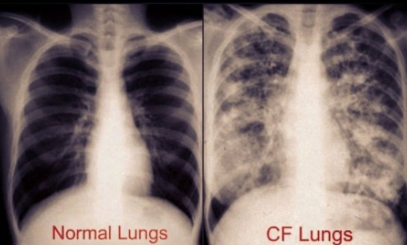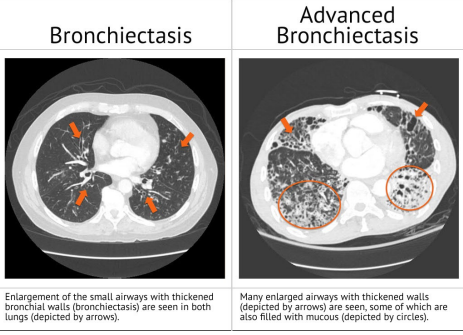Cystic Fibrosis and Bronchiectasis
1/21
There's no tags or description
Looks like no tags are added yet.
Name | Mastery | Learn | Test | Matching | Spaced |
|---|
No study sessions yet.
22 Terms
Cystic Fibrosis
an autosomal recessive genetic disorder affecting the respiratory, digestive, and reproductive systems
CFTR, common, Caucasians, genetic, chloride, mucus, damage
Introduction to Cystic Fibrosis
-Cause: mutation in the ____ gene
-Incidence: most ________ life-threatening genetic disease in Caucasians
-Carrier frequency: 1 in 25 __________ carry a CFTR mutation
-Risk factors: family history, _______ predisposition
-Primary Issue: dysfunctional _______ transport → thick _____ production → multi-organ _________
chloride, epithelial, mucus, infections, pancreatic, infertility
Cystic Fibrosis Pathophysiology
-CFTR gene mutation leads to: defective _______ and water transport across _________ membranes. It also leads to thick, sticky ______ accumulation in lungs, pancreas, and other organs
-Affected systems include: respiratory, gastrointestinal, and reproductive.
-Respiratory: mucus obstruction, chronic _________, and bronchiectasis
-Gastrointestinal: ___________ insufficiency, malabsorption, meconium ileus
-Reproductive: ________ in males due to congenital bilateral absence of the vas deferens
cough, infections, polyps, vitamin, liver, imbalances, thrive
Cystic Fibrosis Clinical Presentation
-Pulmonary Symptoms: chronic ______ with thick mucus, recurrent respiratory ___________, digital clubbing, nasal _______, and sinusitis
-GI Symptoms: failure to thrive, steatorrhea, _______ deficiencies, pancreatitis, _____ disease
-Other: electrolyte __________ and infertility in males
-Neonates: meconium ileus, failure to _______
trypsinogen, chloride, pilocarpine, CFTR, obstructive, FEV1, lipase
Cystic Fibrosis Diagnosis
-Newborn screening: immunoreactive ____________ (IRT) test
-Sweat chloride test: gold standard (>60 mmol/L _______ on two occasions after __________ administration confirms diagnosis)
-Genetic testing: ____ mutation analysis
-Pulmonary function tests (PFTs): shows ____________ pattern with reduced ____, irreversible
-CXR: bronchiectasis, hyperinflation of lungs
-Other labs: hyponatremia, metabolic alkalosis, elevated _______ (pancreatitis)

physiotherapy, saline, mucolytic, chronic, tobramycin, infections, CFTR, transplant
Cystic Fibrosis Treatment and Management: Pulmonary
-Airway clearance therapies: chest _______________, oscillatory devices, hypertonic ________, dornase alfa (_________), and bronchodilators
-Antibiotic therapy: _______ suppressive therapy (Azithromycin), inhaled ___________ for Pseudomonas colonization, and antibiotics for acute pulmonary ____________
-____ modulators: Ivacaftor, lumacaftor/ivacaftor, tezacaftor, elexacaftor
-Lung and/or liver _______: considered in end-stage disease
pancreatic, vitamin, diabetes
Cystic Fibrosis Treatment and Management: Nutrition and GI
-___________ enzyme replacement therapy (PERT)
-Fat-soluble ________ supplementation (A, D, E, K)
-High-calorie, high-protein diet
-Treatment of CF-related __________ (CFRD) if present
failure, infections, obstruction, improving
Cystic Fibrosis Complications
-Respiratory complications: chronic respiratory _________, bronchiectasis, and increased risk of respiratory ___________.
-Gastrointestinal complications: liver disease, intestinal _____________
-Prognosis: median survival ___________ with advanced therapies. Early diagnosis and multidisciplinary care improve outcomes
genetic, sweat, CFTR, essential
Cystic Fibrosis Pearls
-Cystic fibrosis is a _________ disorder affecting multiple organ systems
-______ chloride test is the gold standard for diagnosis
-Pulmonary and gastrointestinal management are key to improving outcomes
-____ modulators have revolutionized treatment
-Multidisciplinary care is ___________ for long-term survival
permanent, bronchi, mucus, damage
Intro to Bronchiectasis
-Bronchiectasis is a chronic lung disease characterized by __________ and irreversible dilation of ______ due to recurrent infections and inflammation
-Key features: ______ accumulation, recurrent infections, and airway ______
imaging, fibrosis, ciliary, autoimmune, inflammation
Bronchiectasis Epidemiology
-Prevalence: increasing due to better __________ and recognition
-Risk Factors: cystic _________ (CF-related vs non-CF bronchiectasis), recurrent respiratory infections, primary _________ dyskinesia, immune deficiencies, _____________ diseases, and aspiration or chronic pulmonary _____________
injury, mucus, damage, dilation
Bronchiectasis Pathophysiology
Cycle of Infection & Inflammation:
Airway ________ due to infection or inflammation
Mucociliary clearance dysfunction → ______ accumulation
Recurrent infections lead to further bronchial _______
Airway ________ and remodeling
productive, purulent, infections, damage, clubbing, wheezing
Bronchiectasis Clinical Presentation
-Chronic ____________ cough with large amounts of _________ sputum (thick, dark brown)
-Recurrent respiratory __________ (Pseudomonas, Haemophilus, Staph Aureus)
-Dyspnea, wheezing, and fatigue
-Hemoptysis (due to airway ________, bronchial artery erosion)
-___________ of fingers (in advanced cases)
-Physical Exam: + crackles, _____________, and rhonchi
abnormal, opacities, HRCT, diagnosis, dilation, obstructive, bacterial, underlying
Bronchiectasis Diagnosis
-CXR: _________, but non-specific with linear atelectasis, tram-track appearance, __________, and increased bronchial markings
-High-resolution CT (____) scan: gold standard for __________. Shows bronchial ________, thickened airway walls, and lack of tapering
-PFTs: often show __________ pattern, decreased FEV1/ratio/FVC
-Sputum cultures: identify ____________ colonization (e.g., Pseudomonas)
-Bronchoscopy: used in select cases to rule out obstruction or malignancy
-Workup for __________ conditions: immunoglobulin levels, CFTR genetic testing, and ciliary function testing

clearance, oscillatory, saline
Bronchiectasis Treatment: Airway ___________ Therapy
-Chest physiotherapy (percussion, postural drainage)
-High-frequency ___________ devices (e.g., vest therapy)
-Hypertonic ________ nebulization (mucolytics)
-Dornase alfa (for CF-related bronchiectasis)
empiric, Fluoroquinolone, aminoglycosides
Bronchiectasis Treatment: Antibiotic Therapy
-Acute exacerbations: ________ coverage based on sputum culture, no culture results start with _______________
-Chronic suppressive therapy: inhaled _______________ (tobramycin for Pseudomonas)
SABAs, corticosteroids
Bronchiectasis Treatment: Bronchodilators and Anti-Inflammatory Therapy
-_______ or LABAs
-Inhaled ______________ (for airway inflammation)
surgical, transplant, immunoglobulin, hemoptysis
Bronchiectasis Treatment: Surgical and Advanced Therapies
-__________ resection: considered in localized disease unresponsive to medical therapy
-Lung __________: for severe, end-stage disease
-Treatment of underlying conditions: _________________ replacement for immune deficiency
-Bronchial artery embolization for ___________
exacerbations, hemoptysis, infections
Bronchiectasis Complications
-Frequent _____________ and respiratory decline
-Massive __________ (due to bronchial artery hypertrophy)
-Pulmonary hypertension and right heart failure (cor pulmonale)
-Secondary ___________ (e.g., Nontuberculous Mycobacteria- NTM)
permanent, HRCT, clearance, underlying
Bronchiectasis Pearls
-Bronchiectasis is a chronic lung disease with _____________ airway dilation
-____ is the gold standard for diagnosis
-Treatment focuses on airway __________, infection control, and inflammation management
-Recognizing and treating __________ causes is crucial
infections, fibrosis, obstruction
Three Hallmark Symptoms of Bronchiectasis
Recurrent respiratory ________
Peribronchial ________
Airway ___________
Tram-Track
sign on chest imaging indicative of bronchiectasis, characterized by parallel lines representing thickened bronchial walls.
